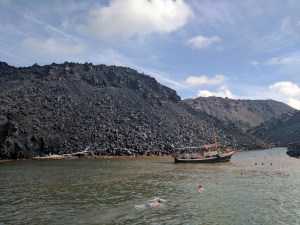Once again the day starts with an early morning walk along the beach front. Yesterday I had three dogs for company. A black one joined first and then two who looked liked twins. Today I don’t see any dogs. Sobha was up and walking already, otherwise it was just miles of black sand, fresh air, clear blue sea and the changing palette of a sky for company. The restaurants lining the seafront do not come to life till much later in the day.
A guy asks me something in Greek, then realising that I didn’t understand him, makes smoking gestures. He wants a cigarette. I wonder, do I look like the beer swilling, cigarette smoking type. Then I remembered seeing our young waitress smoking during her break yesterday at the restaurant. Greeks used to have the highest tobacco consumption in the EU. Maybe they still have.
The hire car arrives at ten and we start our tour of the island. The first stop is Akrotiri, where ancient ruins were excavated in 1967. Akrotiri used to be a major port in the Agean. A thriving community of Minoans lived here during the Bronze Age building elaborate 2-3 storey buildings, with extensive drainage systems, underfloor heating facilities and paved streets. The walls of the buildings were covered in beautiful frescoes. A series of earthquakes shattered their existence and it seems like they fled before a major eruption occurred during the 17th century BC. Ash and pumice covered and preserved this part of Santorini. It laid undiscovered for centuries till around the 1860s when workers digging for pumice during the construction of the Suez Canal accidentally chanced upon it. However it was only finally excavated a century later. Also nicknamed Santorini’s Pompeii, the metres of ash which covered the buildings preserved them well. The wall frescoes have been moved to the Archeological Museum in Athens, but some of the contents such as pottery, can be seen in the buildings.
The houses are made of mud and to preserve them the site is housed in a big purpose built building. The archeological work continues as more of the settlement is excavated. Unlike Pompeii no human or animal remains were found here giving the impression that the people had time to flee before the eruption. The Pompeii eruption was in 79 AD, but the Akrotiri one occurred about 1700 years earlier.
A kilometre further up the hill we reach the path leading to the ‘red beach’ so called because of the dominating red cliffs and red coloured sand. To reach the actual beach, you need to walk along narrow paths up a hill and along the cliff. I overhear a lady mentioning that she was warned that this walk can be dangerous. I look it up later and realise that falling rocks and mudslides can make this a risky venture. The view of the beach from afar is pretty spectacular, closer up the sand is black with a red tinge. The water here is clear similar to the beaches around the island, the volcanic sand has no dust and as a result the water doesn’t get muddy. It is also a good place to snorkel to get a better view of the underwater rocks, but I haven’t brought my goggles or snorkelling gear.
Next a lovely lunch of seafood and salad at a nearby Taverna. They serve us a complimentary Greek yoghurt with a grape syrup for dessert which is just divine. From here we drive to Vylchada, another village near the sea. Along the way we stop at various points to view the caldera. In the sunshine it is pretty spectacular. In Vylchada the cliff formation near the beach is different to the others that we’ve seen and is a giant yellow wall with a honeycomb appearance, where the lava bubbles have left air pockets.
From here we drive to Oia to see the sunset but the sun hides under a massive cloud. We will need to come back again to see it weather permitting.




